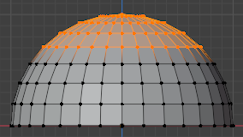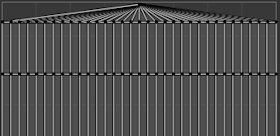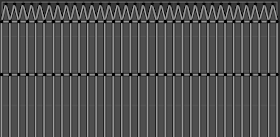Operadores de UV¶
Blender proporciona varias formas de desplegar las UV, desde métodos simples que meramente proyectan los vértices de la malla sobre un plano, hasta métodos muy avanzados.
Desplegar¶
Referencia
- Editor:
Vista 3D
- Modo:
Modo Edición
- Menú:
- Atajo:
U
Referencia
- Editor:
Editor de UV
- Modo:
Modo Edición
- Menú:
- Atajo:
U
Cuts the selected faces along their seams, flattens them, and lays them out on the UV map. Previously existing UV coordinates are overwritten. Useful for organic shapes.
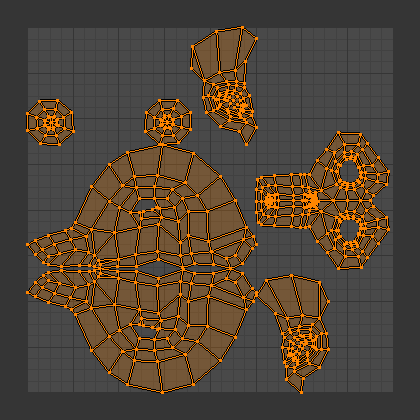
Resultado de desplegar a Suzanne.¶
Opciones¶
El panel Ajustar última operación permite un control preciso sobre cómo se desplegará la malla:
- Método
- Basado en ángulos:
Utilizará un Aplanamiento Basado en Ángulo (ABF en inglés). Este método proporcionará una buena representación 2D de una malla.
- Conforme:
Utilice Mapeo Conforme de Mínimos Cuadrados (LSCM en inglés). Esto generalmente proporciona un mapeo UV menos preciso que el Basado en Ángulos, pero funciona mejor para objetos más simples.
- Estiramiento mínimo:
Uses Scalable Locally Injective Mapping (SLIM). This tries to minimize distortion for both areas and angles.
- Rellenar huecos
Virtually fill holes in the mesh before unwrapping, to better avoid overlaps and preserve symmetry.
- Usar Subdividir superficie
Use the new vertex positions that were calculated by the Modificador Subdividir superficie (rather than the original positions from before any modifiers are run).
- Corregir proporción
Adjusts the UV mapping to account for the aspect ratio of the image associated with the material. This ensures that UVs are scaled correctly when unwrapping onto non-square textures.
For this option to work, the mesh must have a material with an Image Texture node, and this node must be selected in the Shader Editor.
- Iteraciones Estiramiento mínimo
Number of iterations for the Minimum Stretch method, where each iteration reduces the distortion further.
- No invertir Estiramiento mínimo
Disallow flipping faces. Allowing it sometimes results in less distortion when there are pins.
- Influencias de importancia Estiramiento mínimo
Lets you specify a vertex group to manually influence the size of certain faces in the UV map. Faces around high-weight vertices will take up more space in the UV map than ones around low-weight vertices.
When enabling this option, two more appear:
- Grupo de influencias
El nombre del grupo de vértices a ser usado.
- Factor de influencias
A global factor to multiply all the weights by. A bigger number will result in a more exaggerated difference between high-weight and low-weight areas.
- Método de margen
Permitirá escoger el significado del parámetro Margen, que determinará el tamaño del espacio vacío entre las islas UV.
- Escalado
The Margin is a more or less arbitrary measure with no direct relation to the sizes of the UV islands or the texture.
- Agregar
As above, but without the internally calculated scaling factor.
- Fracción
The Margin is a fraction of the UV bounds. This means that, if you have a 1024x1024 texture and set the Margin to 1/1024, each UV island will have a margin of 1 pixel around it (and islands will be no closer than 2 pixels to each other).
- Margen
How much empty space to leave between islands. Controlled by Margin Method.
Proyección UV inteligente¶
Referencia
- Editor:
Vista 3D, Editor de UV
- Modo:
Modo Edición
- Menú:
- Atajo:
U
Examines the angles between the selected faces, cuts them along any sharp edges, then projects each separated group of faces along its average normal and lays it out on the UV map. You can also set up seams for additional cutting. This is a good method for, say, mechanical objects or architecture.
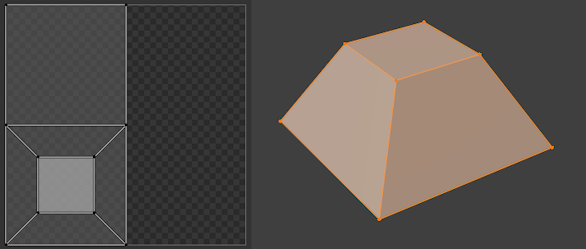
Proyección UV inteligente sobre una pirámide trunca.¶
Opciones¶
El panel Ajustar última operación permite un control preciso sobre cómo se desplegará la malla:
- Límite angular
The maximum allowed angle between the normals of adjacent faces before they’re split off from each other. A low limit will create lots of small UV islands with little distortion, while a high limit will create a few large islands with potentially more distortion.
- Método de margen
The meaning of the Island Margin parameter, which determines the size of the empty space between UV islands.
- Escalado
The Island Margin is a more or less arbitrary measure with no direct relation to the sizes of the UV islands or the texture.
- Agregar
As above, but without the internally calculated scaling factor.
- Fracción
The Island Margin is a fraction of the UV unit square. This means that, if you have a 1024x1024 texture and set the Island Margin to 1/1024, each UV island will have a margin of 1 pixel around it (and islands will be no closer than 2 pixels to each other).
- Método de rotación
- Alinear a eje
Automatically rotate to avoid wasting space.
- Alinear a eje (horizontal)
Rotará las islas para que queden alineadas horizontalmente.
- Alinear a eje (vertical)
Rotará las islas para que queden alineadas verticalmente.
- Margen entre islas
How much empty space to leave between islands. Controlled by Margin Method.
- Influencia según área
With a value of 0, the projection vector of each face group is simply the average of its face normals. With a value of 1, it’s an average that’s weighted using the faces” areas. Other values blend between the two.
- Corregir proporción
Adjusts the UV mapping to account for the aspect ratio of the image associated with the material. This ensures that UVs are scaled correctly when unwrapping onto non-square textures.
For this option to work, the mesh must have a material with an Image Texture node, and this node must be selected in the Shader Editor.
- Escalar hasta límites
Estirará el mapa UV resultante para rellenar la textura completa.
Empacar para mapa de iluminación¶
Referencia
- Editor:
Vista 3D, Editor de UV
- Modo:
Modo Edición
- Menú:
- Atajo:
U
Places each selected face separately on the UV map. Lightmaps are commonly used for baking lighting information into a texture for use in realtime rendering – as such, they prioritize using as much of the texture as possible, typically resulting in a disconnected and distorted UV map that would be unsuitable for manual texturing work.
Opciones¶
El panel Ajustar última operación permite un control preciso sobre cómo se desplegará la malla:
- Selección
- Caras seleccionadas
Sólo desplegará las caras seleccionadas.
- Todas las caras
Desenvolverá la malla completa.
- Compartir espacio de texturizado
You can use Edición de varios objetos a la vez to generate UV maps for multiple meshes at the same time. When Share Texture Space is enabled, the UV maps won’t overlap each other, so that you can later use the same lightmap texture for all the meshes.
- Nuevo mapa UV
Creates a new UV map instead of overwriting the currently selected one. See Mapas UV.
- Calidad de empaque
Higher values result in a UV map that wastes less space (but also takes longer to calculate).
- Margen
How much empty space to leave between the faces in the UV map.
Seguir cuadriláteros activos¶
Referencia
- Editor:
Vista 3D, Editor de UV
- Modo:
Modo Edición
- Menú:
- Atajo:
U
Starts from the active quad and recursively attaches its neighboring, selected mesh quads to its pre-existing UV quad. Non-quad faces are ignored.
Nota
Because the active quad’s UV layout is left unchanged, you’ll typically want to make sure it has the same shape in the UV map as on the mesh before running this unwrap (e.g. by running another type of unwrap on just that face). Otherwise, the distortion will spread to all the other faces.
Nota
The resulting UV map may go out of bounds. You can fix this by manually scaling it down or by using Empacar islas.
Opciones¶
El panel Ajustar última operación permite un control preciso sobre cómo se desplegará la malla:
- Modo longitud bordes
How to calculate the lengths of the UV edges for the newly attached quads.
- Uniforme
Give each new UV edge the same length as the UV edge it’s extending, regardless of its length on the mesh.
- Longitud
Give each new UV edge a length that’s proportional to its length on the mesh.
- Longitud promedio
Give each new UV edge a length that’s proportional to the average edge length in its edge ring on the mesh.
Proyección cúbica¶
Referencia
- Editor:
Vista 3D, Editor de UV
- Modo:
Modo Edición
- Menú:
- Atajo:
U
Projects each selected face onto the most suitable side of a virtual cube, then places all these sides in the UV map, overlapping each other. If you don’t want them to overlap, you can use Empacar islas.
El cubo se encuentra centrado en el Transform Pivot Point y alineado a los ejes locales de la malla.
Opciones¶
El panel Ajustar última operación permite un control preciso sobre cómo se desplegará la malla:
- Tamaño cubo
El tamaño del cubo sobre el cual proyectar.
- Corregir proporción
Adjusts the UV mapping to account for the aspect ratio of the image associated with the material. This ensures that UVs are scaled correctly when unwrapping onto non-square textures.
For this option to work, the mesh must have a material with an Image Texture node, and this node must be selected in the Shader Editor.
- Recortar hasta límites
Moves any out-of-bounds UVs to the nearest border.
- Escalar hasta límites
Estirará el mapa UV resultante para rellenar la textura completa.
Proyección cilíndrica¶
Referencia
- Editor:
Vista 3D, Editor de UV
- Modo:
Modo Edición
- Menú:
- Atajo:
U
Projects the selected faces onto a virtual cylinder, then unrolls that cylinder. The cylinder is centered on the Transform Pivot Point, which is normally the averaged-out position of the selected faces; however, you can also move it to a different place using e.g. the Cursor 3D.
Opciones¶
El panel Ajustar última operación permite un control preciso sobre cómo se desplegará la malla:
- Dirección, Alinear
La dirección del eje central del cilindro.
- Vista en ecuador
Use an axis that’s perpendicular to the viewing direction in the 3D Viewport. If Align is Polar ZX, use the vertical axis of the viewing plane; if it’s Polar ZY, use the horizontal one.
- Vista en polos
Use an axis that’s parallel to the viewing direction in the 3D Viewport. Depending on Align, the cylinder will be rotated by 90° around its axis and the UV map will be shifted horizontally by a quarter.
- Alinear a objeto
Use the object’s local Z axis. Depending on Align, the cylinder will be rotated by 90° around its axis and the UV map will be shifted horizontally by a quarter.
- Polo
Cómo tratar a los vértices que se encuentren sobre el eje central del cilindro.
- Pellizcar
Place all UV versions of the vertex at the same U coordinate. This tends to result in heavily distorted UV faces.
- Abanico
Place each UV version of the vertex at a U coordinate that minimizes distortion.
- Preservar costuras
Cut the mesh along its seams before projecting.
- Radio
Half the height of the cylinder (i.e. not its radius; we’re only using the cylinder for projection, so its radius doesn’t matter).
- Corregir proporción
Adjusts the UV mapping to account for the aspect ratio of the image associated with the material. This ensures that UVs are scaled correctly when unwrapping onto non-square textures.
For this option to work, the mesh must have a material with an Image Texture node, and this node must be selected in the Shader Editor.
- Recortar hasta límites
Moves any out-of-bounds UVs to the nearest border.
- Escalar hasta límites
Estirará el mapa UV resultante para rellenar la textura completa.
Proyección esférica¶
Referencia
- Editor:
Vista 3D, Editor de UV
- Modo:
Modo Edición
- Menú:
- Atajo:
U
Projects the selected faces onto a virtual sphere, then flattens that sphere much like a world map: the latitude lines vertical and the longitude lines evenly spaced. This is useful for texturing spherical shapes such as eyes or planets.
The sphere is centered on the Transform Pivot Point, which is normally the averaged-out position of the selected faces; however, you can also move it to a different place using e.g. the Cursor 3D.
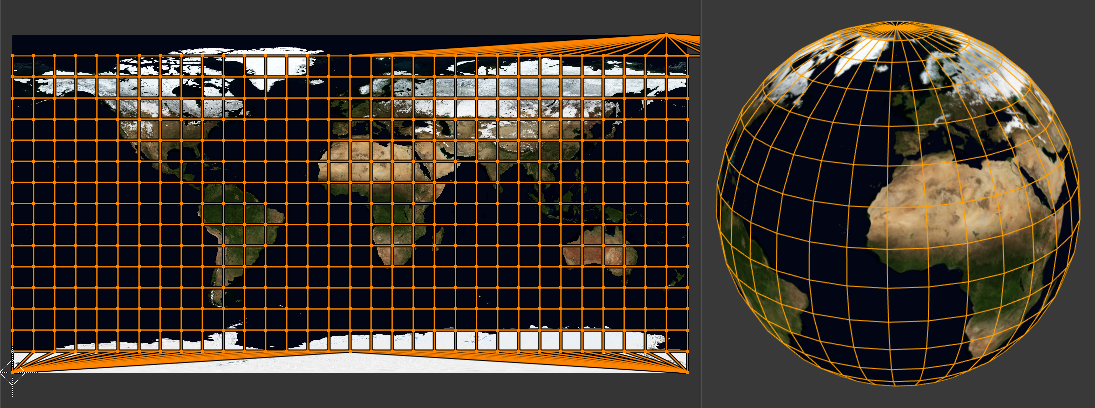
Usando una imagen equirrectangular con una Proyección esférica.¶
Opciones¶
El panel Ajustar última operación permite un control preciso sobre cómo se desplegará la malla:
- Dirección, Alinear
La dirección del eje vertical de la esfera.
- Vista en ecuador
Use an axis that’s perpendicular to the viewing direction in the 3D Viewport. If Align is Polar ZX, use the vertical axis of the viewing plane; if it’s Polar ZY, use the horizontal one.
- Vista en polos
Use an axis that’s parallel to the viewing direction in the 3D Viewport. Depending on Align, the sphere will be rotated by 90° around its vertical axis and the UV map will be shifted horizontally by a quarter.
- Alinear a objeto
Use the object’s local Z axis. Depending on Align, the sphere will be rotated by 90° around its vertical axis and the UV map will be shifted horizontally by a quarter.
- Polo
How to handle vertices that lie on the sphere’s vertical axis. (See Proyección cilíndrica for an example.)
- Pellizcar
Place all UV versions of the vertex at the same U coordinate. This tends to result in heavily distorted UV faces.
- Abanico
Place each UV version of the vertex at a U coordinate that minimizes distortion.
- Preservar costuras
Cut the mesh along its seams before projecting.
- Corregir proporción
Adjusts the UV mapping to account for the aspect ratio of the image associated with the material. This ensures that UVs are scaled correctly when unwrapping onto non-square textures.
For this option to work, the mesh must have a material with an Image Texture node, and this node must be selected in the Shader Editor.
- Recortar hasta límites
Moves any out-of-bounds UVs to the nearest border.
- Escalar hasta límites
Estirará el mapa UV resultante para rellenar la textura completa.
Proyectar desde la vista¶
Referencia
- Editor:
Vista 3D
- Modo:
Modo Edición
- Menú:
- Atajo:
U
Proyectará las caras seleccionadas sobre el plano de la vista. El mapa UV será esencialmente una captura de la estructura de la malla, tomada desde el ángulo de visión actual de la Vista 3D. Usar esta opción en caso de estarse usando una imagen de un objeto real como una textura. Se obtendrá un estiramiento en áreas en donde el modelo se aparte del plano de la vista.
Opciones¶
El panel Ajustar última operación permite un control preciso sobre cómo se desplegará la malla:
- Ortogonal
Use an Orthographic projection instead of Perspective.
- Límites de cámara
Map the borders of the image that would be rendered through the current camera to the borders of the UV map. This option only has an effect when viewing the scene through the camera; see Visualización desde la cámara activa.
- Corregir proporción
Adjusts the UV mapping to account for the aspect ratio of the image associated with the material. This ensures that UVs are scaled correctly when unwrapping onto non-square textures.
For this option to work, the mesh must have a material with an Image Texture node, and this node must be selected in the Shader Editor.
- Recortar hasta límites
Moves any out-of-bounds UVs to the nearest border.
- Escalar hasta límites
Estirará el mapa UV resultante para rellenar la textura completa.
Proyectar desde la vista (hasta límites)¶
Referencia
- Editor:
Vista 3D
- Modo:
Modo Edición
- Menú:
- Atajo:
U
Igual que Proyectar desde la vista, pero con la opción Escalar hasta límites activada de forma predefinida.
Restablecer¶
Referencia
- Editor:
Vista 3D, Editor de UV
- Modo:
Modo Edición
- Menú:
- Atajo:
U
Resets the UV layout of each selected face to fill the whole UV area.
